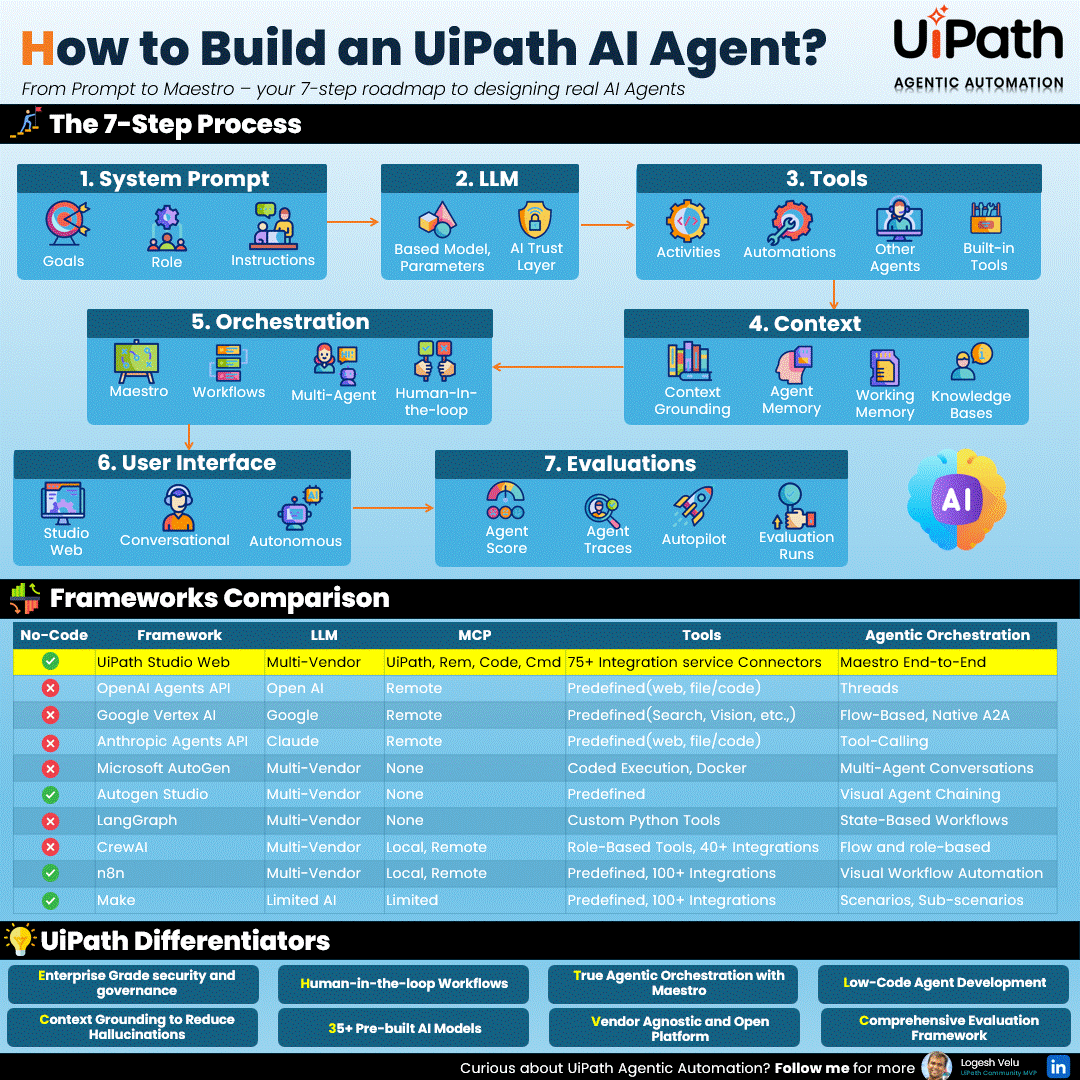A practical 7-step framework for taking AI agents from concept to production with UiPath
Across industries, organizations are experimenting with large language models. But after reviewing dozens of enterprise AI programs, one insight becomes clear:
The value isn’t in connecting to a model — it’s in designing agentic systems that can reason, act, and collaborate securely at scale.
This requires more than prompts. It requires orchestration, governance, context, and alignment between humans, AI, and automation.
Below is a 7-step UiPath framework that helps organizations build real enterprise-grade agents — not isolated LLM demos, but secure, governed, fully orchestrated digital workers.

1. Define Purpose – The System Prompt Layer
Every effective agent begins with clarity.
- Goals: Define measurable outcomes and business KPIs
- Role: Identify whether the agent acts as an assistant, analyst, coordinator, or operator
- Rules: Codify behavioral constraints, compliance guidelines, and boundaries
This becomes the “contract” the agent operates within — ensuring consistency and preventing drift.
2. Govern Models – The AI Trust Layer
Enterprise AI requires responsible operation. UiPath’s AI Trust Layer provides the governance foundation.
- Parameter Management: Control temperature, max tokens, and limits
- AI Guardrails: Detect bias, filter unsafe content, and enforce compliance
- Multi-Model Approach: Support for Azure OpenAI, Anthropic Claude, Gemini, and more
This allows organizations to use multiple models safely, interchangeably, and with centralized governance.
3. Connect Intelligence – Tools and Automations
AI becomes valuable only when it can take action. UiPath connects LLM intelligence to automation.
- 500+ enterprise integrations: SAP, Salesforce, ServiceNow, Workday
- RPA workflow triggering: Let agents execute real business actions
- Multi-agent collaboration: Specialized agents coordinating across processes
This is where “thinking” becomes “doing.”
4. Provide Context – Memory and Grounding
Context shapes reasoning. UiPath ensures agents reason with real enterprise data.
- Context Grounding: Inject CRM, ERP, or transactional data into each request
- Agent Memory: Retain state, history, and learning
- Knowledge Bases: Access organizational documents, guidelines, and policies
With proper grounding, agents stop hallucinating and start behaving like domain specialists.
5. Orchestrate at Scale – UiPath Maestro
Building one agent is easy. Managing dozens or hundreds requires orchestration.
- Workflow automation: Coordinate long-running and complex flows
- Human-in-the-loop: Seamlessly involve people when judgment is required
- Multi-agent orchestration: Agents coordinating decisions and tasks
Maestro brings structure, traceability, and reliability to agentic operations.
6. Design the Experience – Development Options
Different teams need different levels of control. UiPath offers multiple creation paths:
- Studio Web: No-code builder for simple agents
- Studio Desktop: Full development with robust design capabilities
- Conversational interfaces: Build chat- or voice-driven experiences
This flexibility supports developers, analysts, and cross-functional teams.
7. Measure and Improve – Evaluations and Optimization
Agents must improve over time. UiPath provides the evaluation framework.
- Agent scoring: Accuracy, reliability, and performance metrics
- Autopilot optimization: Continuous tuning and self-healing
- Evaluation runs: A/B testing prompts, models, and configurations
Continuous measurement ensures agents remain effective as business needs evolve.
The UiPath Advantage
Enterprises choose UiPath because it provides:
- Enterprise-grade security and governance
- Unified orchestration across agents, robots, and people
- 35+ domain-trained AI models for documents and business use cases
- Low-code tooling that accelerates value without sacrificing control
The future of work is agentic — and UiPath is enabling organizations to build AI agents that are safe, scalable, and production-ready. Partners like qBotica continue to push the boundaries of what’s possible, bringing this capability into real business environments.
Created by
Logesh Velu, UiPath Community MVP 2026
Please reach out if you need anything or have questions.